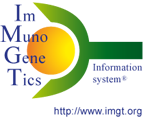Functionality
The definition of functionality is based on the sequence analysis (IMGT Scientific chart) [1].
The 'functionality' concept is part of the 'IDENTIFICATION' axiom of IMGT-ONTOLOGY [2] [3] [4]
As examples, for the IG and TR genes, the instances functional (for germline V-GENE, D-GENE, J-GENE, and for C-GENE) and productive (for rearranged V-J and V-D-J genomic or cDNA entities) mean that the coding regions have an open reading frame without stop codon, and that there is no described defect in the splicing sites, and/or recombination signals, and/or regulatory elements. According to the gravity of the identified defects and to the gene configuration, the functionality can be defined as ORF or pseudogene (for germline V-GENE, D-GENE or J-GENE, and for C-GENE) and unproductive (for rearranged V-J and V-D-J genomic or cDNA entities).
For genes other than IG and TR, the functionality instances are the same as "For Germline IG and TR entities and for C-GENE".
Functionality can be queried from the "Taxonomy,..." module in IMGT/LIGM-DB.
Functionality is shown between:
- parentheses, (F) and (P), when the accession number refers to rearranged genomic DNA or cDNA and the corresponding germline gene has not yet been isolated.
- brackets, [F] and [P], when the accession number refers to genomic DNA, but not known as being germline or rearranged.
References:
[1] Lefranc, M.-P.
IMGT Locus on Focus: a new section of Experimental and Clinical Immunogenetics.
Exp. Clin. Immunogenet., 15, 1-7 (1998)
PMID: 9619395,
LIGM: 199
![]()
[2] Giudicelli, V. and Lefranc, M.-P.
Ontology for Immunogenetics: IMGT-ONTOLOGY.
Bioinformatics, 15, 1047-1054 (1999)
PMID: 10745995,
LIGM: 221
![]()
[3] Giudicelli, V. and Lefranc, M.-P.,
IMGT-ONTOLOGY 2012.
Front Genet. 3:79 (2012).
doi: 10.3389/fgene.2012.00079. Epub 2012 May 23
Online access
PMID:22654892,
LIGM: 401
[4] Lefranc M-P.
Immunoglobulin (IG) and T cell receptor genes (TR): IMGT® and the birth and rise of immunoinformatics.
Front Immunol. Feb 05;5:22 (2014).
doi: 10.3389/fimmu.2014.00022.
Open access.
PMID: 24600447,
LIGM: 429
